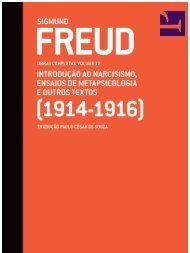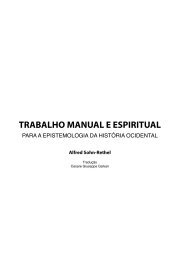Perversion the Social Relation
Perversion the Social Relation
Perversion the Social Relation
- No tags were found...
Create successful ePaper yourself
Turn your PDF publications into a flip-book with our unique Google optimized e-Paper software.
94 Nina SchwartzMiller concedes, <strong>the</strong>n, that much of what we call "perverse," belongingto <strong>the</strong> original energies of human sexuality, "throws into question<strong>the</strong> very notion of normal human sexuality," 5 but fur<strong>the</strong>r claims thatthis definition doesn't take us very far in our thinking about <strong>the</strong> particularstructure of subjectivity that belongs to <strong>the</strong> pervert, a subjectivitythat is as much an effect of living in <strong>the</strong> world as that of <strong>the</strong> neurotic.He thus seeks to begin his own analysis where DoUimore effectivelyconcludes.In <strong>the</strong> Freudian definition of fetishism, <strong>the</strong> pervert copes with <strong>the</strong>threat of castration—<strong>the</strong> sight of <strong>the</strong> female's genitalia—by disavowingwhat he sees and replacing <strong>the</strong> woman's missing penis with a nearby object,<strong>the</strong> fetish: <strong>the</strong> male child repudiates what he "knows" to be truethat<strong>the</strong> mo<strong>the</strong>r is castrated—and persists in his belief in <strong>the</strong> maternalphallus. And yet, Freud says, "He has retained that belief, but he hasalso given it up." 6 <strong>Perversion</strong> here is thus one among o<strong>the</strong>r strategiesfor coping with castration specifically and, perhaps, with loss more generally.According to Bruce Fink's interpretation of Lacan, however, <strong>the</strong>pervert does not so much disavow <strong>the</strong> mo<strong>the</strong>r's castration (and <strong>the</strong>rebyprotect himself from <strong>the</strong> threat of his own), but ra<strong>the</strong>r works to stagethrough his rituals <strong>the</strong> emergence of <strong>the</strong> law that would place a limiton his own (and his mo<strong>the</strong>r's) jouissance: "The aim [of perversion] is tobring <strong>the</strong> law into being: to make <strong>the</strong> O<strong>the</strong>r as law (or law-giving O<strong>the</strong>r)exist." 7 The pervert's experience has failed to provide for him <strong>the</strong> crucialnaming of <strong>the</strong> mo<strong>the</strong>r's lack, and <strong>the</strong> child <strong>the</strong>refore perceives himselfas <strong>the</strong> real object of <strong>the</strong> mo<strong>the</strong>r's desire: "The pervert constituteshimself as what is lacking in <strong>the</strong> mO<strong>the</strong>r; making himself into <strong>the</strong> objectof her desire, he constitutes himself as her object *." 8 The failureof <strong>the</strong> paternal function to bring <strong>the</strong> child fully into <strong>the</strong> symbolic orderand its facilitation of desire's displaceability subject <strong>the</strong> pervert to overwhelminganxiety at <strong>the</strong> mO<strong>the</strong>r's demand, and <strong>the</strong> perverse ritual is hisresponse to <strong>the</strong> demand.This characterization of perversion seems consistent with Miller'sclaim that "perversion is when you do not ask for permission." 9 Desire,always presuming and predicated upon <strong>the</strong> experience of absence, asks,struggles with <strong>the</strong> question of what satisfaction may be, where it maylie; perversion in contrast seems to bypass <strong>the</strong> purpose of such questioningin its assumption that jouissance is directly available. <strong>Perversion</strong> is








